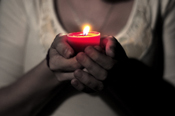 Imagery, metaphor, and simile can engage an audience. Public speakers have deeply affected their audiences with these figures of speech. Analyze the following images, metaphors, and similes from famous speeches and answer the questions that follow using your notes. When you are finished, check your understanding to see possible responses.
Imagery, metaphor, and simile can engage an audience. Public speakers have deeply affected their audiences with these figures of speech. Analyze the following images, metaphors, and similes from famous speeches and answer the questions that follow using your notes. When you are finished, check your understanding to see possible responses. Read the first excerpt and answer the question that follows. You can watch this part of the speech below.

Source: “Light of the World,” Courtney Carmody, Flickr
The energy, the faith, the devotion which we bring to this endeavor will light our country and all who serve it. And the glow from that fire can truly light the world.
Source: John F. Kennedy Inaugural Address Excerpts 1961, FreeTheNation, YouTube
- What is “fire” a metaphor for in this excerpt?
- Fire is a metaphor for the energy, faith, and devotion of the American people.
Read the second excerpt and answer the question that follows. Watch this part of the speech. The excerpt comes about three minutes after the beginning of this clip.
Source: C-SPAN: President-Elect Barack Obama Victory Speech (Full Video), CSPAN, YouTube
It’s the answer told by lines that stretched around schools and churches in numbers this nation has never seen; by people who waited three hours and four hours, many for the very first time in their lives, because they believed that this time must be different; that their voices could be that difference.
- Why do you think President Obama specifically presents the imagery of “lines stretched around schools and churches” and “people who waited three hours and four hours”?
- He is emphasizing the importance of the election and the number of people who believed he could make a difference.
The final excerpt is from Carrie Chapman Catt’s speech “The Crisis” regarding what she perceived as a crisis in women’s rights that would prevent the Nineteenth Amendment to the Constitution (a woman’s right to vote). Read the following excerpt from Catt’s speech and then answer the questions. If it’s possible, read this excerpt aloud.
And we who are the builders of 1916, do we see a crisis? Standing upon these planks, which are stretched across the top-most peak of this edifice of woman’s liberty, what shall we do? Over our heads, up there in the clouds, but tantalizing[ly] near, hangs the roof of our edifice—the vote. What is our duty? Shall we spend time in admiring the capstones and cornice? Shall we lament the tragedies, which accompanied the laying of the cornerstones? Or, shall we, like the builders of old, chant, “Ho! all hands, all hands, heave to! All hands, heave to!” and while we chant, grasp the overhanging roof and with a long pull, a strong pull and a pull together, fix it in place forevermore?
- What metaphor does Catt use to illustrate the suffrage movement? Why is this a good metaphor?
- What does Catt mean when she refers to “capstones,” “cornice,” and “cornerstones”? What does she mean by the “builders of old,” in the next sentence, who chant “Ho! all hands, all hands, heave to! All hands, heave to!”? Explain how and why this language and the rest of the passage helps Catt make her point.
- Catt compares the Suffrage movement to a building. This is a good metaphor for the movement, because they are building something strong and lasting. It is also appropriate because building a building is difficult and does not always go smoothly.
- She is saying that they are spending too much time admiring the work they’ve done so far and complaining about their setbacks. They need to focus and finish their mission to get women the right to vote.